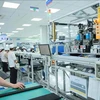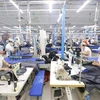Ho Chi Minh City plans to roll out a number of measures to ensure economic progress is in line with sustainable development, striving for an annual GDP growth of up to 10 percent from 2016-2025, stated a municipal senior leader.
Speaking to the Vietnam News Agency on the city’s key future orientations, Chairman of the municipal People’s Committee Le Hoang Quan said the city will prioritise investment in major socio-economic infrastructure programmes while focusing on improving the living conditions of locals and speeding up administrative reform.
Ho Chi Minh City will continue enhancing its competitiveness and international integration and improving human resources quality, he said.
Specifically, the city will continue intensifying high-quality and effective service groups as well as four industries with high science-technology and added value, including mechanics, electronics-information technology, pharmaceutical chemistry-rubber, and food processing, while boosting the support industry and sustainable agricultural development, he said.
Meanwhile, the city will improve the investment environment, focusing on attracting projects using high and green technology.
The municipal leader also stressed the need for the city to mobilise resources for environmental protection as well as coping with climate change and sea level rise while speeding up building rural areas and paying greater attention to developing education-training, science-technology, healthcare, culture and sports.
Reviewing the city’s 40 years of development, Quan said Ho Chi Minh City has made great achievements and important contributions to the country’s industrialisation, modernisation and international integration.
After its liberation in 1975, the city overcame difficulties to secure political stability, surmount the war aftermath, boost economic growth and become a driving force of the country’s economy, he said.
Accounting for only 0.63 percent of the country’s area and 8.8 percent of population, over the past 40 years, Ho Chi Minh City has become a major economic hub of the country with GDP growing to average 10-12 percent annually in recent years from only 2.7 percent from 1976-1985, 1.5 times higher than the national average.
Particularly, the city maintained a growth of 9.6 percent per year from 2011-2015, 1.66 times higher than the country’s average despite the global financial crisis and economic recession.
Economic sectors have been continuously encouraged to grow, stated the city’s leader. Currently, the city has 238,000 enterprises and over 250,000 business households. The city is hosting more than 5,330 foreign investment projects totalling 36.6 billion USD, accounting for a third of the country’s total foreign direct investment projects and one fourth of the total investment.
The city currently contributes 21 percent of the country’s GDP and 30 percent of the State budget.
Ho Chi Minh City has seen progress in urban planning, management and development with several new and modern urban areas.
Social security has been ensured and local income per capita reached 5,131 USD, expected to rise to 5,538 USD by the end of this year. This is a sharp increase compared to that of 2000 at 1,011 USD and 1976 at 360 USD per year.
According to Quan, the city has successfully provided universal secondary education. The city now has 1,500 schools with 1.3 million students and 65,000 teachers.
Municipal healthcare has also been expanded. By the end of 2014, the city had 105 hospitals with a total capacity of 34,000 beds, providing healthcare services to 29 million people with 14.5 doctors for every 10,000 people.
However, Quan also pointed to a number of difficulties, challenges and shortcomings facing the city, including slow transformation of economic structure, modest growth quality and low competitiveness.
It is also encountering a number of common problems experienced by rapidly developed and highly populated cities such as inadequate urban planning and management, overloaded infrastructure, shortages in high-quality human resources, traffic congestion, and environmental pollution, said the city leader.-VNA
Speaking to the Vietnam News Agency on the city’s key future orientations, Chairman of the municipal People’s Committee Le Hoang Quan said the city will prioritise investment in major socio-economic infrastructure programmes while focusing on improving the living conditions of locals and speeding up administrative reform.
Ho Chi Minh City will continue enhancing its competitiveness and international integration and improving human resources quality, he said.
Specifically, the city will continue intensifying high-quality and effective service groups as well as four industries with high science-technology and added value, including mechanics, electronics-information technology, pharmaceutical chemistry-rubber, and food processing, while boosting the support industry and sustainable agricultural development, he said.
Meanwhile, the city will improve the investment environment, focusing on attracting projects using high and green technology.
The municipal leader also stressed the need for the city to mobilise resources for environmental protection as well as coping with climate change and sea level rise while speeding up building rural areas and paying greater attention to developing education-training, science-technology, healthcare, culture and sports.
Reviewing the city’s 40 years of development, Quan said Ho Chi Minh City has made great achievements and important contributions to the country’s industrialisation, modernisation and international integration.
After its liberation in 1975, the city overcame difficulties to secure political stability, surmount the war aftermath, boost economic growth and become a driving force of the country’s economy, he said.
Accounting for only 0.63 percent of the country’s area and 8.8 percent of population, over the past 40 years, Ho Chi Minh City has become a major economic hub of the country with GDP growing to average 10-12 percent annually in recent years from only 2.7 percent from 1976-1985, 1.5 times higher than the national average.
Particularly, the city maintained a growth of 9.6 percent per year from 2011-2015, 1.66 times higher than the country’s average despite the global financial crisis and economic recession.
Economic sectors have been continuously encouraged to grow, stated the city’s leader. Currently, the city has 238,000 enterprises and over 250,000 business households. The city is hosting more than 5,330 foreign investment projects totalling 36.6 billion USD, accounting for a third of the country’s total foreign direct investment projects and one fourth of the total investment.
The city currently contributes 21 percent of the country’s GDP and 30 percent of the State budget.
Ho Chi Minh City has seen progress in urban planning, management and development with several new and modern urban areas.
Social security has been ensured and local income per capita reached 5,131 USD, expected to rise to 5,538 USD by the end of this year. This is a sharp increase compared to that of 2000 at 1,011 USD and 1976 at 360 USD per year.
According to Quan, the city has successfully provided universal secondary education. The city now has 1,500 schools with 1.3 million students and 65,000 teachers.
Municipal healthcare has also been expanded. By the end of 2014, the city had 105 hospitals with a total capacity of 34,000 beds, providing healthcare services to 29 million people with 14.5 doctors for every 10,000 people.
However, Quan also pointed to a number of difficulties, challenges and shortcomings facing the city, including slow transformation of economic structure, modest growth quality and low competitiveness.
It is also encountering a number of common problems experienced by rapidly developed and highly populated cities such as inadequate urban planning and management, overloaded infrastructure, shortages in high-quality human resources, traffic congestion, and environmental pollution, said the city leader.-VNA



















